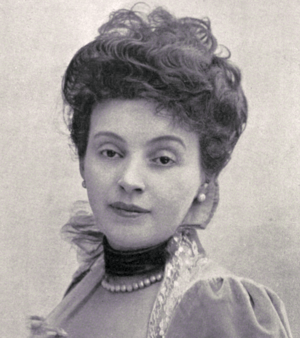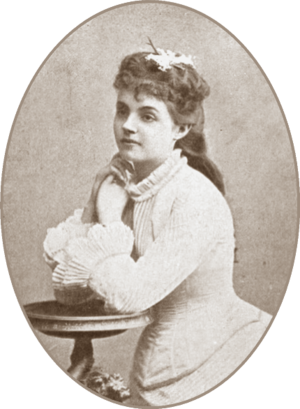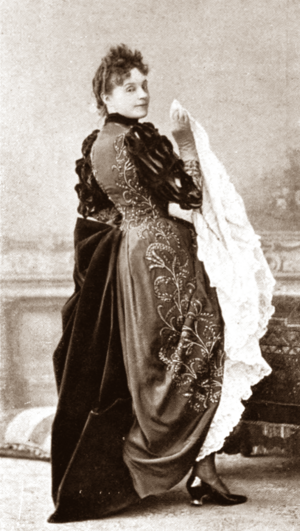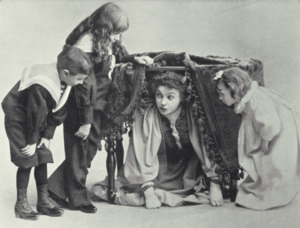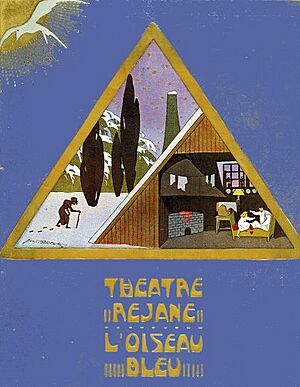Gabrielle Réjane facts for kids
Gabrielle Réjane (French pronunciation: [ɡabʁijɛl ʁeʒan]), born Gabrielle Charlotte Réju (June 6, 1856 – June 14, 1920), was a famous French actress. She was active in the late 1800s and early 1900s.
Réjane's father was an actor. She studied at the Paris Conservatoire, a famous acting school. She first performed on stage in 1875. After acting for eight seasons at the Théâtre du Vaudeville, she became a main star at the Théâtre des Variétés. She also performed in serious plays at other theatres.
She was best known for her roles in comedies. However, she also impressed audiences in serious parts. Her biggest success was playing Catherine in Madame Sans-Gêne. Catherine was a bold washerwoman who became a duchess. Réjane first played this role in 1893 and continued to perform it for many years. Another famous role was Nora in Henrik Ibsen's A Doll's House in 1894. This play became very popular in France because of her performance.
Réjane performed in major cities across Europe, especially in London. She was very popular there and played often between 1877 and 1915. She also performed twice on Broadway in New York, but American audiences did not connect with her as much. She married the director of the Vaudeville theatre and starred there. After their divorce in 1905, she opened her own theatre. She managed it until 1918. Between 1900 and 1920, she appeared in six silent films. These included two versions of Madame Sans-Gêne. Many people saw her as the perfect example of a Parisian woman. When she died in 1920, the newspaper Le Figaro said that Paris had lost its soul.
Contents
Life and Career
Early Acting Years
Gabrielle Réjane was born in Paris, France, on June 6, 1856. Her father was a former actor who worked at the Théâtre de l'Ambigu-Comique. He passed away when Réjane was about five years old. This left her mother in a difficult financial situation. Her mother found a job at another Paris theatre. Young Réjane helped the family by painting fans to earn extra money.
Her schooling was interrupted in 1870–71 by the Siege of Paris and the Commune. After the fighting, she went back to school. She even became a paid assistant, helping to look after younger students.
Réjane dreamed of becoming an actress. Her mother reluctantly agreed. Réjane then successfully applied to study with François-Joseph Regnier. He was a respected actor and teacher at the Paris Conservatoire. In 1874, she won the Conservatoire's second prize for comedy. Some critics believed she deserved the first prize. However, the first prize usually meant joining the famous Comédie-Française theatre. The judges thought Réjane's lively face wasn't quite right for that grand theatre.
Réjane was supposed to join France's second national theatre, the Odéon. But she preferred the plays and better pay at the Théâtre du Vaudeville. She made her first appearance at the Vaudeville in 1875. She immediately made a strong impression. A reviewer said she had the "arch and sprightly air of a Parisian grisette". She also had a pleasant voice and was very confident on stage. These qualities were more than enough for her to succeed.
Later that year, she had her first big success as Niquette in Fanny Lear. She stayed at the Vaudeville for eight seasons and received good reviews. Another star, Julia Bartet, got most of the main roles. But Réjane still made her mark.
In 1877, Réjane made her first of many trips to London. Parisian theatres often closed for a few weeks in summer. In July, she performed at the Gaiety Theatre in London with her Vaudeville colleagues. Critics praised her "vivacity" and found her "infinitely diverting".
Rising to Stardom
In 1882, Réjane became the main actress at the Théâtre des Variétés. Her contract there allowed her to take on more serious roles at other theatres. In 1883, Sarah Bernhardt, another famous actress, cast Réjane in a main role in La Glu. In this play and in Ma camarade, Réjane received very positive reviews.
Over the next ten years, Réjane performed in many different plays at several Paris theatres. She acted in new works and revivals of classic plays. These included Le mariage de Figaro and Lysistrata. She constantly showed how talented she was. In 1887, in Allô-Allô, she played a scene struggling with a new telephone. It was so funny that the whole theatre roared with laughter.
The next year, she appeared in a play based on Germinie Lacerteux. The director André Antoine described her amazing performance. He said she transformed from an elegant Parisian into a poor maid. She became "Germinie Lacerteux herself." He added that she truly achieved greatness in the second part of the play.
Marcel Proust, a famous writer, saw her performance and became a big fan. His character Berma, a great actress in his book À la recherche du temps perdu, was partly based on Réjane.
In 1893, Réjane married Paul Porel, who was the director of the Vaudeville theatre. They had two children, Germaine and Jacques. She performed in many successful plays at the Vaudeville. Two early productions showed her wide range of acting skills.
In October 1893, she created the role she would be most known for: Catherine in Madame Sans-Gêne. Catherine was a bold washerwoman who became a duchess. Critics and the public loved her performance. One reviewer said Réjane made the character "delicious, feminine and overwhelming." Another wrote that she made Catherine both "fascinating and playful" and "proud almost to sublimity." People flocked to the Vaudeville just to see Réjane in this role.
Six months later, Réjane played Nora in the first French performance of Henrik Ibsen's A Doll's House. Ibsen's plays had not been popular in Paris before this. But to his delight, this production was a huge success. Critics said Réjane's performance was one of the greatest of her career. She showed the complex character of Nora with "rare simplicity." She also showed "admirable dramatic power" in a famous scene. One critic wrote that her acting was "extraordinary" and that she moved from "lightest gaiety" to "tragic heights."
London and New York Performances
In 1894, Réjane returned to London. Her performances in Madame Sans-Gêne received rave reviews and filled theatres. Her season had to be extended because so many people wanted to see her.
In February 1895, Réjane opened at Abbey's Theatre in New York. She performed Madame Sans-Gêne, A Doll's House, and other plays. Critics gave Réjane excellent reviews. However, the plays themselves were not as popular, and audiences were not very responsive. One American writer explained that understanding French was necessary to appreciate Réjane's acting. Also, some American audiences found the content of French plays too bold. The New York Times later said Réjane was "hampered by the moral bias of American audiences."
Réjane was so disappointed that she promised never to return to the U.S. She took her company back to Paris through London. There, they performed the same plays to full houses at the Garrick Theatre. Madame Sans-Gêne was a huge hit again. Sir Henry Irving, a famous English actor, bought the rights to create an English version. He produced it with Ellen Terry playing Réjane's role two years later.
Réjane eventually changed her mind and agreed to return to the U.S. But this did not happen until 1904. By then, she had performed for audiences in many other European countries. Meanwhile, her marriage was breaking down. In 1905, she and Porel divorced. Her children stayed with her. Since the Vaudeville theatre was now closed to her, Réjane decided to manage her own theatre.
Théâtre Réjane and Later Years
Réjane quickly found a new theatre home. In 1906, the writer Arnold Bennett described how she took over the Nouveau Théâtre. She completely rebuilt it and renamed it the Théâtre Réjane. Everyone went to see it. It became a wonderful theatre, very spacious and beautifully decorated. Bennett wrote that "Réjane was written all over it." Paris was "charmed, astounded, electrified."
At the Théâtre Réjane, she performed in twenty new plays and revivals between 1906 and 1910. These plays helped keep her amazing talent active. Réjane did not act in every production at her theatre. For example, she was not in the French premiere of The Blue Bird in 1911. She also performed at other Paris theatres, like the Théâtre de la Porte Saint-Martin.
Réjane also hoped to start a French theatre in London. She took a first step in 1906 with a season at the Royalty Theatre. However, the plan did not go further. Réjane sold her Paris theatre in 1918. After that, its name was changed to the Théâtre de Paris.
Réjane appeared in six silent films. Two of them were versions of Madame Sans-Gêne, made in 1900 and 1911. Other films included Britannicus (1908) and L'Assomoir (1909).
During the First World War, Réjane worked hard to help the Allied forces. She performed in patriotic plays in London, such as Alsace and The Bet. She was awarded the Chevalier of the Legion of Honour, a very important French award. This was celebrated in February 1920 with a lunch at the Théâtre de Paris.
Gabrielle Réjane died from influenza in Paris on June 14, 1920, at age 64. The next day, the newspaper Le Figaro wrote that Paris had lost its soul.
Images for kids
See also
 In Spanish: Gabrielle Réjane para niños
In Spanish: Gabrielle Réjane para niños


